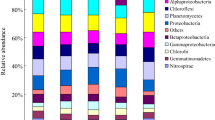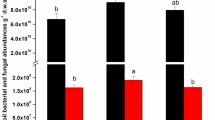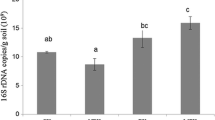Abstract
Background and aims
Peanut yield and quality are seriously compromised by continuous monoculturing in the red soil region of southern China. Monoculturing can cause soil degradation and an increase in soil-borne diseases. This research aimed to investigate the influence of long-term peanut monocropping and different fertilization treatments on peanut growth, soil physical and chemical properties and soil microbial community.
Methods
A long-term fertilization experiment established in 1996 was utilized to examine the effect of various fertilization treatments including chemical and organic fertilizers treatments. Deep 16S rRNA gene pyrosequencing highlighted changes in the abundance and structure of bacterial communities, especially of the pathogenic and beneficial bacterial communities in long term chemical fertilizer treatment in comparison to the organic manure treatment.
Results
Chemical fertilizer treatment causes a shift in bacterial community structure and decrease in diversity under the long-term monocropping in comparison to organic fertilizer. The abundance of the bacterial pathogen Ralstonia solanacearum, a causative agent of peanut wilt, was found to be associated with a loss of community diversity and loss of the peanut yield.
Conclusions
The organic fertilizers more effectively increase microbial diversity in the soil and changed the community structure. Long-term use of the chemical fertilizer leads to a decrease in microbial diversity of the soil and an increase in R. solanacearum with associated increase of peanut wilt. The potential decrease in diversity and competition between the bacterial community and the pathogen may be a contributing factor to increased disease during long-term chemical fertilizer use.






Similar content being viewed by others
References
Acosta-Martínez V, Burow G, Zobeck TM, Allen VG (2010) Soil microbial communities and function in alternative systems to continuous cotton. Soil Sci Soc Am J 74:1181–1192
Allen C, Prior P, Hayward AC (2005) Bacterial wilt disease and the Ralstonia solanacearum species complex. American Phytopathological Society (APS Press)
Bell T, Newman JA, Silverman BW, Turner SL, Lilley AK (2005) The contribution of species richness and composition to bacterial services. Nature 436:1157–1160
Buckley DH, Huangyutitham V, Nelson TA, Rumberger A, Thies JE (2006) Diversity of planctomycetes in soil in relation to soil history and environmental heterogeneity. Appl Environ Microbiol 72:4522–4531
Cao ZP, Han XM, Hu C, Chen J, Zhang DP, Yosef S (2011) Changes in the abundance and structure of a soil mite (Acari) community under long-term organic and chemical fertilizer treatments. Appl Soil Ecol 49:131–138
Cardinale BJ, Srivastava DS, Duffy JE, Wright JP, Downing AL, Sankaran M, Jouseau C (2006) Effects of biodiversity on the functioning of trophic groups and ecosystems. Nature 443:989–992
Chaney RL, Munns JB, Cathey HM (1980) Effectiveness of digested sewage sludge compost in supplying nutrients for soilless potting media. J Am Soc Hortic Sci 150:485–493
Chaudhry V, Rehman A, Mishra A, Chauhan PS, Nautiyal CS (2012) Changes in bacterial community structure of agricultural land due to long-term organic and chemical amendments. Microb Ecol 64:450–460
Chen HG, Li FD, Chen YX (1981) Soil microbiology. Shanghai Science Technology Press, Shanghai (in Chinese)
Chen ZJ, Sheng XF, He LY, Huang Z, Zhang WH (2013) Effects of root inoculation with bacteria on the growth, Cd uptake and bacterial communities associated with rape grown in Cd-contaminated soil. J Hazard Mater 244:709–717
Chistoserdova L, Jenkins C, Kalyuzhnaya MG, Marx CJ, Lapidus A, Vorholt JA, Staley JT, Lidstrom ME (2004) The enigmatic planctomycetes may hold a key to the origins of methanogenesis and methylotrophy. Mol Biol Evol 21:1234–1241
Colwell RK (2009) EstimateS: statistical estimation of species richness and shared species from samples. Version 8.2. User’s guide and application published at: http://purl.oclc.org/estimates
Costa AL, Paixão SM, Caçador I, Carolino M (2007) CLPP and EEA profiles of microbial communities in salt marsh sediments. J Soils Sediments 7:418–425
Crecchio C, Curci M, Mininni R, Ricciuti P, Ruggiero P (2001) Short-term effects of municipal solid waste compost amendments on soil carbon and nitrogen content, some enzyme activities and genetic diversity. Biol Fertil Soils 34:311–318
Das R, Kazy SK (2014) Microbial diversity, community composition and metabolic potential in hydrocarbon contaminated oily sludge: prospects for in situ bioremediation. Environ Sci Pollut Res 21:7369–7389
Esperschütz J, Gattinger A, Mäder P, Schloter M, Fliessbach A (2007) Response of soil microbial biomass and community structures to conventional and organic farming systems under identical crop rotations. FEMS Microbiol Ecol 61:26–37
Fierer N (2009) A comprehensive survey of soil acidobacterial diversity using pyrosequencing and clone library analyses. ISME J 3(4):442–453
Freitag TE, Chang L, Clegg CD, Prosser JI (2005) Influence of inorganic nitrogen management regime on the diversity of nitrite-oxidizing bacteria in agricultural grassland soils. Appl Environ Microbiol 71:8323–8334
Girvan MS, Bullimore J, Pretty JN, Osborn AM, Ball AS (2003) Soil type is the primary determinant of the composition of the total and active bacterial communities in arable soils. Appl Environ Microbiol 69:1800–1809
Hill P, Krištůfek V, Dijkhuizen L, Boddy C, Kroetsch D, van-Elsas JD (2011) Land use intensity controls actinobacterial community structure. Microb Ecol 61:286–302
Hu J, He X, Li D, Liu Q (2007) Progress in research of Sphingomonas. Chin J Appl Environ Biol 13:431
Huang MY, Gu WJ, Zhang FB, Xu PZ, Yang SH, Wang LQ, Xie KZ (2011) Identification and fermentation of antagonistic bacterium against Ralstonia solanacearum. Chin Microbiol 38:214–220
Hugenholtz P, Goebel BM, Pace NR (1998) Impact of culture-independent studies on the emerging phylogenetic view of bacterial diversity. J Bacteriol 180:4765–4774
Ji XL, Lu GB, Gai YP, Zheng CC, Mu ZM (2008) Biological control against bacterial wilt and colonization of mulberry by an endophytic Bacillus subtilis strain. FEMS Microbiol Ecol 65:565–573
Justin PN, Emily BH, Ma.del Carmen AGC, Frank MH, David AZ, Jacqueline AAP, Richard L, Terry J (2012) Impacts of cropping systems and long-term tillage on soil microbial population levels and community composition in Dryland agricultural setting. ISRN Ecology. doi:10.5402/2012/487370
Kong AYY, Scow KM, Córdova-Kreylos AL, Holmes WE, Six J (2011) Microbial community composition and carbon cycling within soil microenvironments of conventional, low-input, and organic cropping systems. Soil Biol Biochem 43:20–30
Kumar R, Pandey S, Pandey A (2006) Plant roots and carbon sequestration. Curr Sci 91:885–890
Larkin RP (2003) Characterization of soil microbial communities under different potato cropping systems by microbial population dynamics, substrate utilization, and fatty acid profiles. Soil Biol Biochem 35:1451–1466
Lauber CL, Strickland MS, Bradford MA, Fierer N (2008) The influence of soil properties on the structure of bacterial and fungal communities across land-use types. Soil Biol Biochem 40:2407–2415
Lauber CL, Hamady M, Knight R, Fierer N (2009) Pyrosequencing-based assessment of soil pH as a predictor of soil bacterial community structure at the continental scale. Appl Environ Microbiol 75:5111–5120
Li YM, Hu JC, Zhang J, Wang SL (2005) Microbial diversity in continuously planted Chinese fir soil. Chin J Appl Ecol 16:1275–1278
Li PD, Dai CC, Wang XX, Zhang TL, Chen Y (2012) Variation of soil enzyme activities and microbial community structure in peanut monocropping system in subtropical China. Afr J Agric Res 7:1870–1879
Li XG, Ding CF, Hua K, Zhang TL, Zhang YN, Zhao L, Yang YR, Liu JG, Wang XX (2014a) Soil sickness of peanuts is attributable to modifications in soil microbes induced by peanut root exudates rather than to direct allelopathy. Soil Biol Biochem 78:149–159
Li XG, Ding CF, Zhang TL, Wang XX (2014b) Fungal pathogen accumulation at the expense of plant-beneficial fungi as a consequence of consecutive peanut monoculturing. Soil Biol Biochem 72:11–18
Lian CY, Wang XX, Li YL (2010) Effects of planting peanut and applying urea and organic materials on acidity of red soil. Soils (in Chinese) 42:822–827
Lin XG, Feng YZ, Zhang HY, Chen RR, Wang JH, Zhang JB, Chu HY (2012) Long-term balanced fertilization decreases arbuscular mycorrhizal fungal diversity in an arable soil in north china revealed by 454 pyrosequencing. Environ Sci Technol 46:5764–5771
Lipson DA, Schmidt SK (2004) Seasonal changes in an alpine soil bacterial community in the Colorado Rocky Mountains. Appl Environ Microbiol 70:2867–2879
Liu X, He XY (1991) Progress and achievement in the research on red soil in Jiangxi. Acta Agric Jiangxi (in Chinese) 1:014
Liu JG, Li YB, Jiang GY, Bian XM, Li F, Geng W (2008) Allelopathic effects of cotton in continuous cropping. Allelopathy J 21:299–306
Liu YX, Shi JX, Feng YG, Yang XM, Li X, Shen QR (2012) Tobacco bacterial wilt can be biologically controlled by the application of antagonistic strains in combination with organic fertilizer. Biol Fertil Soils 47:239–248
Lu RK (1999) Analytical methods of soil agricultural chemistry. China Agriculture Science and Technology Press, Beijing (in Chinese)
Lwin M, Ranamukhaarachchi SL (2006) Development of biological control of Ralstonia solanacearum through antagonistic microbial populations. Int J Agric Biol 8(5):657–660
Mannisto MK, Tiirola M, Haggblom MM (2007) Bacterial communities in Arctic fjelds of Finnish Lapland are stable but highly pH-dependent. FEMS Microbiol Ecol 59:452–465
Margulies D, Melman G, Shanzer A (2005) Fluorescein as a model molecular calculator with reset capability. Nat Mater 4:768–771
Marschner P, Kandeler E, Marschner B (2003) Structure and function of the soil microbial community in a long-term fertilizer experiment. Soil Biol Biochem 35:453–461
Marschner P, Crowley D, Yang CH (2004) Development of specific rhizosphere bacterial communities in relation to plant species, nutrition and soil type. Plant Soil 261:199–208
Marta AP, Juan DA, Claudia SB, María JA (2014) 11 - role of Actinobacteria in bioremediation. Microb Biodegrad Biorem 2014:269–286
Mays DA, Giordano DM (1989) Land spreading municipal waste compost. Biocycle 30:37–39
McAndrew DW, Malhi SS (1992) Long-term N fertilization of a solonetzic soil: effects on chemical and biological properties. Soil Biol Biochem 24:619–623
Melero S, Madejon E, Herencia JF, Ruiz JC (2008) Effect of implementing organic farming on chemical and biochemical properties of an irrigated loam soil. Agron J 100:136–144
Mikhail MS, Sabet KK, Mohamed ME, Kenawy MH, Kasem KK (2005) Effect of compost and macronutrients on some cotton seedling diseases. Egypt J Phytopathol 33:41–52
Moreira D (1998) Efficient removal of PCR inhibitors using agarose-embedded DNA preparations. Nucleic Acids Res 26:3309–3310
Naeem S, Li S (1997) Biodiversity enhances ecosystem reliability. Nature 390:507–509
Naumoff DG, Dedysh SN (2012) Lateral gene transfer between the Bacteroidetes and Acidobacteria: the case of α-L-rhamnosidases. FEBS Lett 586:3843–3851
Nie LX, Peng SB, Bouman BAM, Huang J, Cui K, Vispera RM, Xiang J (2008) Alleviating soil sickness caused by aerobic monocropping: responses of aerobic rice to nutrient supply. Field Crop Res 107:129–136
Nishio M, Kusano S (1973) Fungi associated with roots of continuously cropped upland rice. Soil Sci Plant Nutr 19:205–217
Oskay AM, Usame T, Cem A (2005) Antibacterial activity of some actinomycetes isolated from farming soils of Turkey. Afr J Biotechnol 3:441–446
Peacock AD, Mullen MD, Ringelberg DB, Tyler DD, Hedrick DB, Gale PM, White DC (2001) Soil microbial community responses to dairy manure or ammonium nitrate applications. Soil Biol Biochem 33:1011–1019
Ramesh R, Joshi A, Ghanekar M (2009) Pseudomonads: major antagonistic endophytic bacteria to suppress bacterial wilt pathogen, Ralstonia solanacearum in the egg plant (Solanum melongena L.). World J Microbiol Biotechnol 25:47–55
Reeves DW (1997) The role of soil organic matter in maintaining soil quality in continuous cropping systems. Soil Tillage Res 43:131–167
Ribeiro H, Mucha AP, Marisa R, Almeida C, Bordalo AA (2013) Bacterial community response to petroleum contamination and nutrient addition in sediments from a temperate salt marsh. Sci Total Environ 458:568–576
Saha S, Prakash V, Kundu S, Kumar N, Minna BL (2008) Soil enzymatic activity as affected by long term application of farm yard manure and mineral fertilizer under a rainfed soybean–wheat system in N–W Himalaya. Eur J Soil Biol 44:309–315
Sarathchandra SU, Ghani A, Yeates GW, Burch G, Cox NR (2001) Effect of nitrogen and phosphate fertilisers on microbial and nematode diversity in pasture soils. Soil Biol Biochem 33:953–964
Schloss PD, Gevers D, Westcott SL (2011) Reducing the effects of PCR amplification and sequencing artifacts on 16S rRNA-based studies. PLoS One 6, e27310
Spain AM, Lee RK, Elshahed MS (2009) Abundance, composition, diversity and novelty of soil Proteobacteria. ISME J 3:992–1000
Wang MZ, Chen XN (2005) Obstacle and countermeasure of sustainable high yield for peanut in low-hilly red soil region. J Peanut Sci (in Chinese) 34:17–22
Wang XB, Luo YM, Li ZG, Liu WX, He YQ (2011) Effects of long-term stationary fertilization experiment on incidence of soil-borne diseases and biological characteristics of peanut in continuous monocropping system in red soil area. Acta Pedol Sin 48:725–730
Watts DB, Torbert HA, Feng Y, Prior SA (2010) Soil microbial community dynamics as influenced by composted dairy manure, soil properties, and landscape position. Soil Sci 175:474–486
Wu M, Qin H, Chen Z, Wu J, Wei W (2011) Effect of long-term fertilization on bacterial composition in rice paddy soil. Biol Fertil Soils 47:397–405
Xu K, Tang Y, Ren C, Zhao K, Sun Y (2013) Diversity and abundance of n-alkane-degrading bacteria in the near-surface soils of a Chinese onshore oil and gas field. Biogeosciences 10:2041–2048
Yuan SF, Wang LL, Wu K, Shi JX, Wang MS, Yang XM, Shen QR, Shen B (2014) Evaluation of Bacillus-fortified organic fertilizer for controlling tobacco bacterial wilt in greenhouse and field experiments. Appl Soil Ecol 75:86–94
Zheng SX, Hu JL, Chen K, Yao J, Yu ZN, Lin XG (2009) Soil microbial activity measured by microcalorimetry in response to long-term fertilization regimes and available phosphorous on heat evolution. Soil Biol Biochem 4:2094–2099
Zhou XG, Gao DM, JLiu J, Qiao PL, Zhou XL, Lu HB, Wu X, Liu D, Jin X, Wu FZ (2014) Changes in rhizosphere soil microbial communities in a continuously monocropped cucumber (Cucumis sativus L.) system. Eur J Soil Biol 60:1–8
Acknowledgments
We thank National Natural Science Foundation of China (41471236, 41325003) and Jiangsu Provincial Natural Science Foundation of China (BK2012891) for financial support.
Author information
Authors and Affiliations
Corresponding author
Additional information
Responsible Editor: John A. Kirkegaard.
Rights and permissions
About this article
Cite this article
Liu, W., Wang, Q., Wang, B. et al. Changes in the abundance and structure of bacterial communities under long-term fertilization treatments in a peanut monocropping system. Plant Soil 395, 415–427 (2015). https://doi.org/10.1007/s11104-015-2569-3
Received:
Accepted:
Published:
Issue Date:
DOI: https://doi.org/10.1007/s11104-015-2569-3




